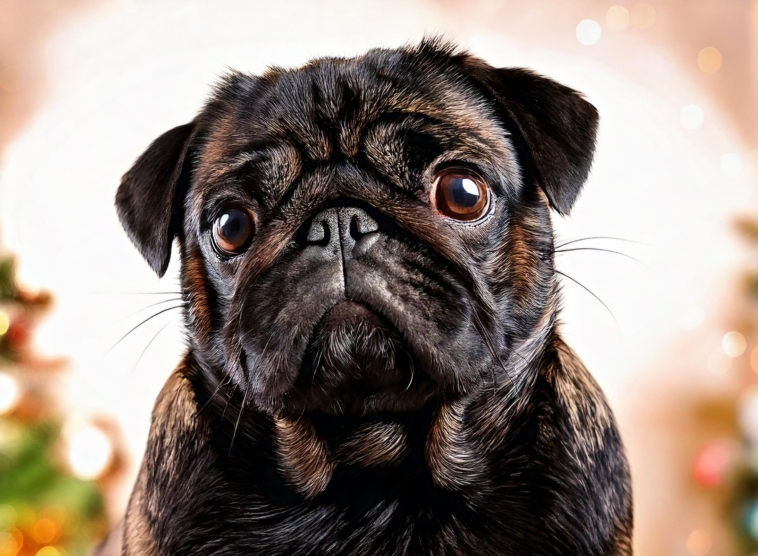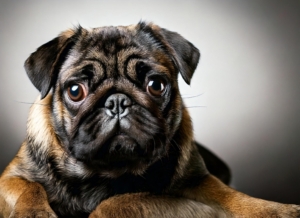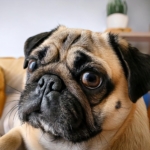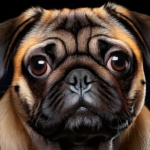Introduction: Meet the Reverse Brindle Pug – Stylish, Striped, and Seriously Squishy
Reverse Brindle Pugs are the fashionistas of the pug set. While the typical pug ambles about in plain fawn or black, these trendy little rule-breakers arrive in bespoke pinstripes. Rather than the standard dark-over-light brindle pattern, reverse brindle pugs promenade around with light stripes over a dark ground—essentially, the tuxedo variant of pug style. High-brow? Yes. High-maintenance? Perhaps a bit.
Characteristics of Reverse Brindle Pugs
- Coat Pattern: Picture a little, rumpled tiger who loves naps and belly rubs. That is your pug.
- Temperament: Devoted, loving, and nicely mischievous.
- Size: Small, sturdy, and shaped like a loaf of bread with legs.
- Lifespan: 12 to 15 years, provided they’re spoiled rotten (which they will be).
History: Pugs, Royals, and the Rise of the Reverse Brindle
Pugs have been living large since ancient China, lounging about with emperors and likely receiving more attention than most aristocrats. They arrived in Europe in the 16th century and took over royal lap space and couches straight away.
And the brindle coat? Selective breeding is the reason—someone must have wanted their pug to resemble a miniature jungle cat who doubles as a couch potato.
Physical Traits: What Makes Them Stand Out
- Coat: Whirly, swirly, marvelous. It’s as if a barista created your pug from a mocha latte.
- Size: Weighs roughly as much as a miniature bowling ball—lap warming and guilt-tripping you into not rising to perfection.
- Body: Sturdy with a wide chest. Imagine a bodybuilder only small, mushy, and wheezes a lot.
- Face: The quintessential pug mug—short snout, wrinkles aplenty, and the look of someone who has just woken up from a nap they didn’t sign up for.
- Ears: Rose or button-shaped, and ideal for accidentally flipping inside-out during play.
Personality & Behavior
- Affectionate: Clingy in the best possible way. Count on constant companionship and side-eyes if you dare leave the room.
- Playful: Always ready for a romp—until they’re not. Then it’s nap time. Again.
- Stubborn: If “selective hearing” were an Olympic sport, these pugs would have gold medals.
- Sociable: Loves people, pets, and attention. Will insist on being the center of your universe.
- Smart-ish: They know what you want… they just don’t always care.
Care Tips: Keeping the Pug Life Happy
- Diet: Top-of-the-line food only. No fast food, no matter how hard they glower.
- Exercise: Walks are a must, even if they feign that their legs don’t exist when the leash is produced.
- Grooming: Brushing them regularly keeps their coat smooth and your furniture not as hairy.
- Vet Visits: Yes, even if they attempt to hide behind the couch.
- Training: Positive reinforcement is the way to go. Bribery with treats? Better.
Health Woes (And What to Watch For)
As is often the case with pugs, the reverse brindle has some quirks in the engine:
- Brachycephalic Syndrome: Otherwise known as “snorts like a cartoon pig.”
- Skin Conditions: Those folds are adorable but drama-prone. Clean and dry them regularly.
- Hip Dysplasia: Be cautious of wobbly gait.
- Eye Issues: Their large eyes are adorable but trouble magnets.
- Knee Slippage (Patellar Luxation): Occasionally their knees engage in peekaboo.
Routine check-ups are a necessity—even if they play betrayed each and every time.
Training: How to Outsmart a Pug (Good Luck)
- Positive Reinforcement: Treats, praise, applause. Essentially, be like they won an Oscar.
- Be Consistent: Rule changes = pug confusion = standoff at pug strength.
- Keep it Short: Goldfish attention span. Possibly shorter.
- Socialization: Get them exposed to new sights, sounds, and smells early on.
- Patience: You will need it. A lot of it.
- Crate Training: Nice for potty training and providing them with their own “fort.”
- Leash Training: For the dramatic sidewalk flops during walks.
- Don’t Yell: They won’t hear—and may even stare at you like you’ve lost your mind.
Diet: Keep It Lean, Keep It Clean
- Protein: Small but strong. Feed them accordingly.
- Healthy Fats: For energy and that shiny “Instagrammable” coat.
- Vitamins: Keep those joints and eyeballs in top condition.
- Water: Always keep fresh water on hand—pugs get parched from all that huffing.
- Watch the Fillers: Steer clear of trash food masquerading as healthy.
- Portion Control: Pugs love food nearly as much as they love naps. Don’t let them fool you into a second dinner.
Pop Culture Pugs: Internet Royalty
Reverse brindle pugs have left their mark:
- TV & Movies: Because when you’re in need of an adorable sidekick who’s a piglet name-taker and a cinnamon bun looker, why not?
- Social Media: Instagram is pretty much 50% brunch photos and 50% pug videos at this point.
- Commercials: Brand managers love them, and why would they not? They’re wrinkled, wiggly, and weirdly photogenic.
Choosing a Breeder (Because Not All Are Created Equal)
- References: If the breeder has more red flags than a James Bond film, flee.
- Health Screening: Demand evidence, not guarantees.
- Facility Visit: If you wouldn’t sleep there, neither should your new pug.
- Experience: Ensure they are well-versed in their brindle from their rudimentary.
- Contracts: Read between the lines. Particularly the health warranties.
- Ethics: Purchase from somebody who truly cares for the dogs—not the cash.
Final Thoughts: Why Reverse Brindle Pugs Might Just Be Your patronus
- Personality: Half clown, half cuddlebug.
- Size: Apartment-sized, lap-warming.
- Grooming: A small brushing, a lot of hugs.
- Good with Kids: Especially those who enjoy sharing snacks.
- Sociable: Essentially a four-legged extrovert.
- Loyal: Once you’re theirs, you’re theirs forever.
In short, reverse brindle pugs are living cartoons. They snort, snuggle, sass—and they’ll steal your heart (and your couch) in less time than it takes to say “walk?





